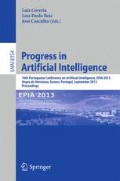Abstract
Intelligent systems should be able to initiate and understand social interactions, which are always brought about by physical actions. Thus, all physical actions need to be interpreted for their social effects. This paper gives an analytical framework that identifies the main challenges in modelling social interactions. Such interpretation is subjective and might lead to misunderstandings between participants in the interaction. In real life, people use rituals, such as greetings, as a method for common grounding. Greeting as an essential prerequisite of joint activity is taken as case study to illustrate our approach.
Access this chapter
Tax calculation will be finalised at checkout
Purchases are for personal use only
Preview
Unable to display preview. Download preview PDF.
References
Bentahar, J., Colombetti, M., Dignum, F., Fornara, N., Jones, A., Singh, M., Chopra, A., Artikis, A., Yolum, P.: Research directions in agent communication. ACM Transactions on Intelligent Systems and Technology 4(2), 1–27 (2013)
Argyle, M.: Social Interaction. Transaction Publishers Rutgers (2009)
Clark, H.: Using Language. Cambridge University Press (1996)
Condon, W.S., Ogston, W.D.: Sound film analysis of normal and pathological behavior patterns. J. Nervous Mental Disorders 143, 338–347 (1966)
Lesser, V., Decker, K.: Generalizing the partial global planning algorithm. International Journal of Intelligent Cooperative Information Systems 1(2), 319–346 (1992)
Durkheim, E.: The Rules of Sociological Method, 8th edn.
Grosz, B.J., Kraus, S.: Collaborative plans for complex group action. Artificial Intelligence 86(2), 269–357 (1996)
Jennings, N.R.: Controlling cooperative problem solving in industrial multi-agent systems using joint intentions. Artificial Intelligence 75(2), 195–240 (1995)
Kendon, A.: Movement coordination in social interaction: some examples described. Acta Psychologica 32, 101–125 (1970)
Decker, K., Wagner, T., Carver, N., Garvey, A., Horling, B., Neiman, D., Podorozhny, R., Nagendra Prasad, M., Raja, A., Vincent, R., Xuan, P., Lesser, V., Zhang, X.Q.: Evolution of the GPGP/TAEMS Domain-Independent Coordination Framework. International Journal of Autonomous Agents and Multi-Agent Systems 9(1), 87–143 (2004)
Cohen, P.R., Levesque, H.J., Nunes, J.H.T.: On acting together. In: Proceedings of the Eighth National Conference on Artificial Intelligence (AAAI 1990), pp. 94–99 (1990)
Pynadath, D., Marsella, S.: Psychsim: Modeling theory of mind with decision-theoretic agents. In: Proc. of the Internat. Joint Conference on Artificial Intelligence, pp. 1181–1186 (2005)
Rummel, R.J.: Understanding conflict and war, vol. 2. Sage Publications (1976)
Searle, J.R.: The Construction of Social Reality. Penguin (1996)
Thompson, L., Fine, G.A.: Socially shared cognition, affect and behavior: A review and integration. Personality and Social Psychology Review 3, 278–302 (1999)
Turner, J.H.: A theory of social interaction. Stanford University Press (1988)
Vilhjálmsson, H.H., Kopp, S., Marsella, S., Thórisson, K.R. (eds.): IVA 2011. LNCS (LNAI), vol. 6895. Springer, Heidelberg (2011)
Author information
Authors and Affiliations
Editor information
Editors and Affiliations
Rights and permissions
Copyright information
© 2013 Springer-Verlag Berlin Heidelberg
About this paper
Cite this paper
Dignum, F., Dignum, V., Jonker, C.M. (2013). The Social Meaning of Physical Action. In: Correia, L., Reis, L.P., Cascalho, J. (eds) Progress in Artificial Intelligence. EPIA 2013. Lecture Notes in Computer Science(), vol 8154. Springer, Berlin, Heidelberg. https://doi.org/10.1007/978-3-642-40669-0_40
Download citation
DOI: https://doi.org/10.1007/978-3-642-40669-0_40
Publisher Name: Springer, Berlin, Heidelberg
Print ISBN: 978-3-642-40668-3
Online ISBN: 978-3-642-40669-0
eBook Packages: Computer ScienceComputer Science (R0)

